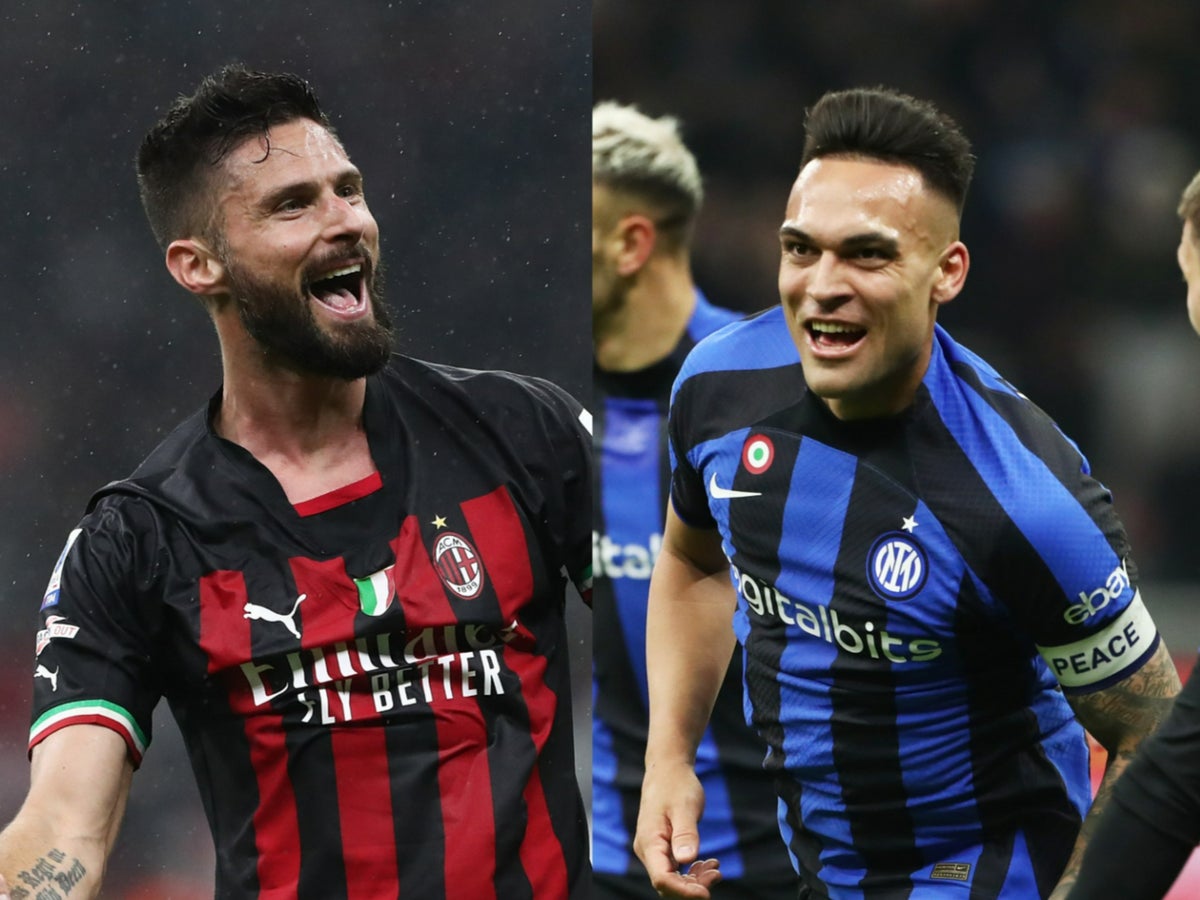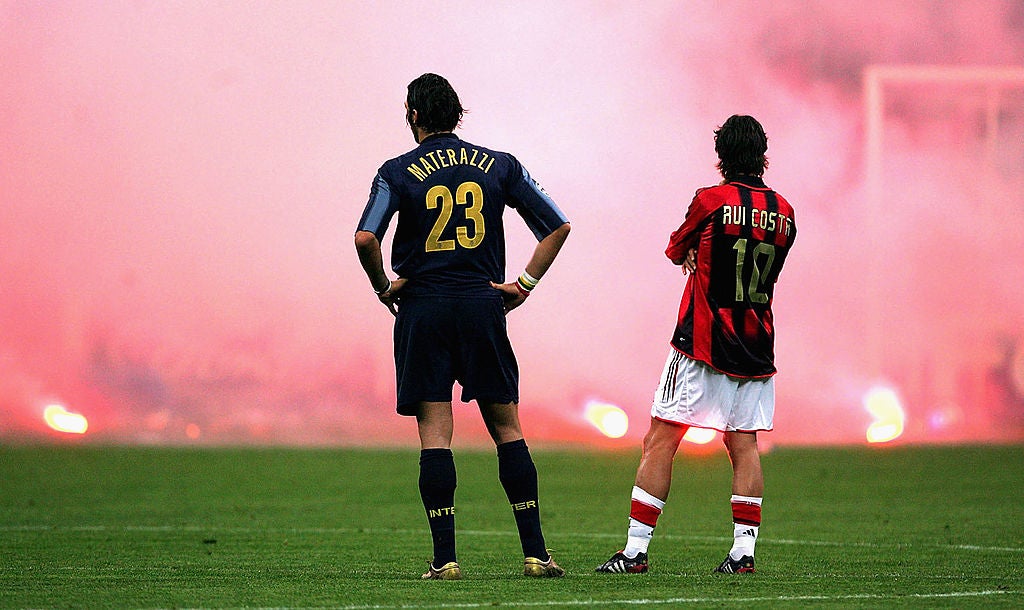
At the training grounds of both Milan clubs this week, the players have been enduring the same feeling that many of their more distinguished predecessors did in 2003. It is one that might run against all of the understandable excitement leading up to a second Champions League semi-final derby between Internazionale and AC Milan. That feeling is that this is not a game to really be enjoyed, or even looked forward to in any way. Then, 20 years ago, Alessandro Costacurta was already one of the most decorated players in football but he felt a tension before that match that he hadn’t ever experienced in his career. Not before his first European Cup final in 1989. Not before the World Cup final in 1994.
It was a fear of failure, that the cost of defeat to your greatest rivals was much greater than the value of victory. Little wonder the tie only featured one goal. And these were teams that had far more medals and football status than their successors today.
That is what makes the feeling now all the deeper, because the stakes are consequently so much higher. It is not just a precious chance at Champions League glory, with the pride of beating your city rivals. It is that there is no guarantee either will be back next season, or any time soon. This is not Andriy Shevchenko, Javier Zanetti, Hernan Crespo or Fabio Cannavaro, all of whom would have viewed the 2003 tie as the sort of game they should regularly be involved in. Many of these players might not get that opportunity, at least at these clubs.
That is just another way the atmosphere around this Milan derby runs contrary to the reality.
The very history and setting fosters the sense of the greatest glamour in the game. It was little wonder the San Siro has been described as “the Scala of football”. It was for a long time the home of the greatest stars in the sport, as well as the European Cup itself. With 10 victories between them, the Milan clubs have been champions in 15% of the competition’s 67 seasons so far. Madrid is the only city with more European Cups, at 14, but they are all housed in the Bernabeu.
“Right now, Milan is the biggest football city in Europe,” Shevchenko said in 2005, when the two clubs again met for the 2005 quarter-final. It will be difficult for anyone not to feel the same as they approach the famous grey columns and red girders of the San Siro on Wednesday night. The very fact Milan and Inter are meeting again at this stage has similarly fired the argument that Serie A is back.
This, a bit like the emotion of the players going into the game, is where it gets complicated. Serie A has clearly made immense strides in the last half-decade, and that from a situation where it was facing a full crisis. It could even be said it is now Europe’s second league behind England. Italy does remain the home of tactical innovation, primarily due to the depth of thinking that comes from the Coverciano coaching school.
The starting XIs from the 2002-03 Champions League semi-final second leg
AC Milan: Dida, Alessandro Costacurta, Alessandro Nesta, Paolo Maldini, Khaka Kaladze, Andrea Pirlo, Gennaro Gattuso, Clarence Seedorf, Rui Costa, Andriy Shevchenko, Filippo Inzaghi
Internazionale: Francesco Toldo; Ivan Cordoba, Marco Materazzi, Fabio Cannavaro, Francesco Coco, Javier Zanetti, Sergio Conceicao, Luigi Di Biagio, Emre Belezoglu, Alvaro Recoba, Hernan Crespo
That has played into a refreshing variety of playing styles, that make it stand apart from the homogenous frenetic pressing of the Bundesliga and the increasingly stale possession of La Liga. That variety also corresponds with a new competitive vitality, largely due to the vacuum left by Juventus. Napoli may have run away with the league this season, but they will be the third different champions in three years, with huge unpredictability beneath them.
This is the new reality of Italian football, that makes it more compelling. Clubs from quite far down the table can think they have a chance at a title challenge. Hence these two great clubs can reach this grand stage while both struggling to finish in the top four this season.
Much of this has been influenced by innovative and influential work at clubs like Atalanta, Sassuolo and Napoli but also a specific type of American owner that wants to do things differently. They have identified an under-appreciated value in football - for want of a better phrase - and feel it can be maximised through the most modern methods.
All of these factors have come together to force one of Europe’s most conservative and protective football cultures into a new age.

Milan, in winning the Scudetto last season for the first time in 11 years, arguably typify this more than anyone. That comes from a situation where the two clubs had to adapt to a new reality, where they no longer represent the most dominant model in the game. For over 40 years, after all, Milan and Inter were run by a series of emotionally invested industrialists and moguls who could basically outbid anyone in football. It was why, a little like the Premier League now, Serie A could pay wages nobody else could reach. This is what brought so many of the stars that illuminated the atmosphere around that 2003 tie and so many decades of football. It is why, when you think of a Milan derby in the Champions League, you don’t really think of Nicolo Barella or Fikayo Tomori, with respect. You think of so many that came before, from Ronaldo to Marco van Basten.
The Premier League has now just gone to a far greater scale, driven by broadcasting revenue and a new strand of ownership attracted by such economic and social capital. The most recognisable of those moguls - Silvio Berlusconi and Massimo Moratti - gradually realised they could not compete in a football market with state ownership like Manchester City’s, so checked out.
The problem provoked a debate within the San Siro, where former players like Zvonimar Boban argued about the idea of “a Milan player”, who had to be grand enough to wear the shirt. The modernists within the new club infrastructure insisted it would be wasteful to overspend trying to pay for such players. It is largely this, after all, which has Internazionale in such financial problems now.
So, while their rivals will decide on starting a £100m signing like Romelu Lukaku on Wednesday, Milan will instead turn to players such as Rafael Leao who may be worth £100m in the future. They went against the arguments of Boban, and sought the modern route. Analytics would be prioritised to seek undervalued players, and build the future. Inter have been much more about the present, which was never more obvious than when at last winning the league again under a coach like Antonio Conte.
It also points to how all of this is just an adaptation to the modern game, which has been pretty much the case with the Champions League this season. One of the only reasons the discussion about Serie A’s prospective return is being had is because of the blind luck of the draw. The three strongest sides left in the competition in City, Real Madrid and Bayern Munich were all put on one side. All of the Italians left were put on the other. We might not have such a fixture at all with one change.

The Milan clubs nevertheless made the best of this. Inter were already developing that kind of dogged momentum that comes with cup runs, personified by Milan Skriniar. Manager Simone Inzaghi has no defined style but knows how to adapt for individual games.
Milan have meanwhile decided to define their new era with that modern pressing game, but Stefano Piolo of course had the presence of mind to completely temper it for Napoli. They picked off the new Serie A champions, just as they did in the league.
This is a contrast that conditions the tie.
Due to their big spending, Inter are more individual-based, with more decisive attacking players. The suggestions are that Inzaghi may go for both Lauturo Martinez and Lukaku, who have the capacity to be a tough challenge for any team. They also have the capacity for games where they do nothing, a problem accentuated by the fact Inter often create so little. They don’t have Milan’s tactical ideology, so are more dependent on rising to the occasion in any given game. It is just as well Inzaghi has so far brought this out in the Champions League. As one figure who has worked with both clubs says, “there is an enormous difference between Inter’s worst performance and their best”.
That isn’t seen as the case with Milan, due to a more defined way of playing. That approach means there is always attacking service. Such underlying consistency has driven this Champions League run, and ensured they have overcome poor Serie A form.
Many around Milan would also insist that it is also just the “magic” that comes over the club when they play in the Champions League. Back in those glory days of the mid-2000s, some players occasionally put on the famous competition theme to try and get a response in poor league campaigns.

“I don’t know what happens to us when we hear the Champions League music,” former CEO Adriano Galliani once said. “We’ll have to ask a psychologist.”
Mentality similarly weighs over this tie, but potentially with the opposite effect. It may well suffocate the game. There’s also the fact that, as both clubs have found for the last decade, “magic” can only run against reality for so long.
This is what colours the debate over whether Serie A is back. Both clubs know that the wealthiest clubs - most of them coming from the Premier League - are just waiting to pick off their teams. That may happen in Istanbul, after this semi-final.
Milan have made it part of their strategy. Inter this summer need it. It points to how both have adapted to the modern game. This semi-final will be a showcase of that, rather than the traditional glamour of Milan the football city. It is why it means all the more, even if it doesn't look like what it was.







